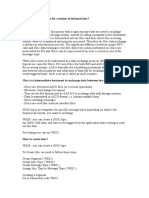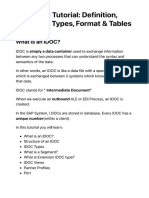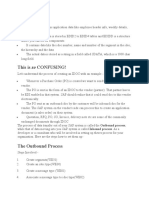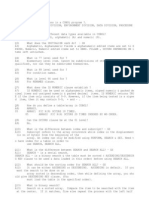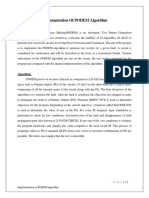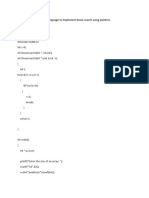0 ratings0% found this document useful (0 votes)
70 viewsIdocs
Idocs
Uploaded by
amberbhatia12IDocs are structured documents used to exchange data between SAP systems or between SAP and external systems. They allow for asynchronous data exchange. To create an IDoc, you need to define IDoc segments, create an IDoc type from the segments, define a message type, and assign the IDoc type to the message type. You then configure partner profiles and processing rules to enable IDoc exchange between systems.
Copyright:
Attribution Non-Commercial (BY-NC)
Available Formats
Download as DOC, PDF, TXT or read online from Scribd
Idocs
Idocs
Uploaded by
amberbhatia120 ratings0% found this document useful (0 votes)
70 views3 pagesIDocs are structured documents used to exchange data between SAP systems or between SAP and external systems. They allow for asynchronous data exchange. To create an IDoc, you need to define IDoc segments, create an IDoc type from the segments, define a message type, and assign the IDoc type to the message type. You then configure partner profiles and processing rules to enable IDoc exchange between systems.
Original Title
idocs
Copyright
© Attribution Non-Commercial (BY-NC)
Available Formats
DOC, PDF, TXT or read online from Scribd
Share this document
Did you find this document useful?
Is this content inappropriate?
IDocs are structured documents used to exchange data between SAP systems or between SAP and external systems. They allow for asynchronous data exchange. To create an IDoc, you need to define IDoc segments, create an IDoc type from the segments, define a message type, and assign the IDoc type to the message type. You then configure partner profiles and processing rules to enable IDoc exchange between systems.
Copyright:
Attribution Non-Commercial (BY-NC)
Available Formats
Download as DOC, PDF, TXT or read online from Scribd
Download as doc, pdf, or txt
0 ratings0% found this document useful (0 votes)
70 views3 pagesIdocs
Idocs
Uploaded by
amberbhatia12IDocs are structured documents used to exchange data between SAP systems or between SAP and external systems. They allow for asynchronous data exchange. To create an IDoc, you need to define IDoc segments, create an IDoc type from the segments, define a message type, and assign the IDoc type to the message type. You then configure partner profiles and processing rules to enable IDoc exchange between systems.
Copyright:
Attribution Non-Commercial (BY-NC)
Available Formats
Download as DOC, PDF, TXT or read online from Scribd
Download as doc, pdf, or txt
You are on page 1of 3
hi hope it will help you. +*Reward if help.
*+ Data Creation in Idoc IDocs are text encoded documents
with a rigid structure that are used to exchange data between R/3 and a foreign system. Instead of
calling a program in the destination system directly, the data is first packed into an IDoc and then sent
to the receiving system, where it is analyzed and properly processed. Therefore an IDoc data
exchange is always an asynchronous process. The significant difference between simple RFC-calls
and IDoc data exchange is the fact, that every action performed on IDocs are protocolled by R/3 and
IDocs can be reprocessed if an error occurred in one of the message steps. While IDocs have to be
understood as a data exchange protocol, EDI and ALE are typical use cases for IDocs. R/3 uses
IDocs for both EDI and ALE to deliver data to the receiving system. ALE is basically the scheduling
mechanism that defines when and between which partners and what kind of data will be exchanged
on a regular or event triggered basis. Such a set-up is called an ALE-scenario. IDoc is a intermediate
document to exchange data between two SAP Systems. *IDocs are structured ASCII files (or a virtual
equivalent). *Electronic Interchange Document *They are the file format used by SAP R/3 to
exchange data with foreign systems. *Data Is transmitted in ASCII format, i.e. human readable form
*IDocs exchange messages *IDocs are used like classical interface files IDOC types are templates for
specific message types depending on what is the business document, you want to exchange. WE30 -
you can create a IDOC type. An IDOC with data, will have to be triggered by the application that is
trying to send out the data. FOr testing you can use WE19. How to create idoc? *WE30 - you can
create a IDOC type For more information in details on the same along with the examples can be
viewed on: http://www.netweaverguru.com/EDI/HTML/IDocBook.htm#_Toc8400404
http://help.sap.com/saphelp_erp2005/helpdata/en/0b/2a6620507d11d18ee90000e8366fc2/frameset.h
tm http://www.sappoint.com/presentation.html http://www.allsaplinks.com/idoc_search.html
http://www.sapgenie.com/sapedi/idoc_abap.htm http://www.erpgenie.com/sapedi/idoc_abap.htm To
Create Idoc we need to follow these steps: Create Segment ( WE31) Create Idoc Type ( WE30 )
Create Message Type ( WE81 ) Assign Idoc Type to Message Type ( WE82 ) Creating a Segment Go
to transaction code WE31 Enter the name for your segment type and click on the Create icon Type
the short text Enter the variable names and data elements Save it and go back Go to Edit -> Set
Release Follow steps to create more number of segments Create IDOC Type Go to transaction code
WE30 Enter the Object Name, select Basic type and click Create icon Select the create new option
and enter a description for your basic IDOC type and press enter Select the IDOC Name and click
Create icon The system prompts us to enter a segment type and its attributes Choose the appropriate
values and press Enter The system transfers the name of the segment type to the IDOC editor. Follow
these steps to add more number of segments to Parent or as Parent-child relation Save it and go
back Go to Edit -> Set release Create Message Type Go to transaction code WE81 Change the
details from Display mode to Change mode After selection, the system will give this message “The
table is cross-client (see Help for further info)”. Press Enter Click New Entries to create new Message
Type Fill details Save it and go back Assign Message Type to IDoc Type Go to transaction code
WE82 Change the details from Display mode to Change mode After selection, the system will give
this message “The table is cross-client (see Help for further info)”. Press Enter. Click New Entries to
create new Message Type. Fill details Save it and go back Check these out..
https://www.sdn.sap.com/irj/sdn/thread?forumID=50&threadID=217884&messageID=2402859 Check
below link. It will give the step by step procedure for IDOC creation. http://www.supinfo-
projects.com/cn/2005/idocs_en/2/ ALE/ IDOC
http://help.sap.com/saphelp_erp2004/helpdata/en/dc/6b835943d711d1893e0000e8323c4f/content.ht
m http://www.sapgenie.com/sapgenie/docs/ale_scenario_development_procedure.doc
http://edocs.bea.com/elink/adapter/r3/userhtm/ale.htm#1008419
http://www.netweaverguru.com/EDI/HTML/IDocBook.htm http://www.sapgenie.com/sapedi/index.htm
http://www.sappoint.com/abap/ale.pdf http://www.sappoint.com/abap/ale2.pdf
http://www.sapgenie.com/sapedi/idoc_abap.htm
http://help.sap.com/saphelp_erp2005/helpdata/en/0b/2a60bb507d11d18ee90000e8366fc2/frameset.h
tm
http://help.sap.com/saphelp_erp2005/helpdata/en/78/217da751ce11d189570000e829fbbd/frameset.h
tm http://www.allsaplinks.com/idoc_sample.html http://www.sappoint.com/abap.html
http://help.sap.com/saphelp_erp2004/helpdata/en/dc/6b835943d711d1893e0000e8323c4f/content.ht
m http://www.sapgenie.com/sapgenie/docs/ale_scenario_development_procedure.doc
http://edocs.bea.com/elink/adapter/r3/userhtm/ale.htm#1008419
http://www.netweaverguru.com/EDI/HTML/IDocBook.htm http://www.sapgenie.com/sapedi/index.htm
http://www.allsaplinks.com/idoc_sample.html
http://www.sapgenie.com/sapgenie/docs/ale_scenario_development_procedure.docs go trough these
links.
http://help.sap.com/saphelp_erp2004/helpdata/en/dc/6b835943d711d1893e0000e8323c4f/content.ht
m http://www.sapgenie.com/sapgenie/docs/ale_scenario_development_procedure.doc
http://edocs.bea.com/elink/adapter/r3/userhtm/ale.htm#1008419
http://www.netweaverguru.com/EDI/HTML/IDocBook.htm http://www.sapgenie.com/sapedi/index.htm
http://www.sappoint.com/abap/ale.pdf http://www.sappoint.com/abap/ale2.pdf
http://www.sapgenie.com/sapedi/idoc_abap.htm
http://help.sap.com/saphelp_erp2005/helpdata/en/0b/2a60bb507d11d18ee90000e8366fc2/frameset.h
tm
http://help.sap.com/saphelp_erp2005/helpdata/en/78/217da751ce11d189570000e829fbbd/frameset.h
tm http://www.allsaplinks.com/idoc_sample.html http://www.sappoint.com/abap.html
http://help.sap.com/saphelp_erp2004/helpdata/en/dc/6b835943d711d1893e0000e8323c4f/content.ht
m http://www.sapgenie.com/sapgenie/docs/ale_scenario_development_procedure.doc
http://edocs.bea.com/elink/adapter/r3/userhtm/ale.htm#1008419
http://www.netweaverguru.com/EDI/HTML/IDocBook.htm http://www.sapgenie.com/sapedi/index.htm
http://www.allsaplinks.com/idoc_sample.html
http://http://help.sap.com/saphelp_erp2004/helpdata/en/dc/6b835943d711d1893e0000e8323c4f/conte
nt.htm An IDoc is simply a data container that is used to exchange information between any two
processes that can understand the syntax and semantics of the data... 1.IDOCs are stored in the
database. In the SAP system, IDOCs are stored in database tables. 2.IDOCs are independent of the
sending and receiving systems. 3.IDOCs are independent of the direction of data exchange. The two
available process for IDOCs are Outbound Process Inbound Process AND There are basically two
types of IDOCs. Basic IDOCs Basic IDOC type defines the structure and format of the business
document that is to be exchanged between two systems. Extended IDOCs Extending the functionality
by adding more segments to existing Basic IDOCs. To Create Idoc we need to follow these steps:
Create Segment ( WE31) Create Idoc Type ( WE30) Create Message Type ( WE81) Assign Idoc Type
to Message Type ( WE82) imp links http://www.allsaplinks.com/idoc_sample.html
http://www.sapgenie.com/sapedi/idoc_abap.htm www.sappoint.com --here u can find the ppts and
basic seetings for ALE http://sappoint.com/presentation.html www.sapgenie.com
http://www.sapgenie.com/ale/index.htm WE30 - you can create a IDOC type. An IDOC with data, will
have to be triggered by the application that is trying to send out the data. Try this..Hope this will help.
>>>> SAP ALE & IDOC<<<< Steps to configuration(Basis) >> 1. Create Logical System (LS) for each
applicable ALE-enabled client 2. Link client to Logical System on the respective servers 3. Create
background user, to be used by ALE(with authorizaton for ALE postings) 4. Create RFC
Destinations(SM59) 5. Ports in Idoc processing(WE21) 6. Generate partner profiles for sending
system The functional configuration(Tcode: SALE) • Create a Customer Distribution Model (CDM); •
Add appropriate message types and filters to the CDM; • Generate outbound partner profiles; •
Distribute the CDM to the receiving systems; and • Generate inbound partner profiles on each of the
clients. Steps to customize a new IDoc >>> 1. Define IDoc Segment (WE31) 2. Convert Segments
into an IDoc type (WE30) 3. Create a Message Type (WE81) 4. Create valid Combination of Message
& IDoc type(WE82) 5. Define Processing Code(WE41 for OUT / WE42 for IN) 6. Define Partner
Profile(WE20) Important Transaction Codes: SALE - IMG ALE Configuration root WE20 - Manually
maintain partner profiles BD64 - Maintain customer distribution model BD71 - Distribute customer
distribution model SM59 - Create RFC Destinations BDM5 - Consistency check (Transaction
scenarios) BD82 - Generate Partner Profiles BD61 - Activate Change Pointers - Globally BD50 -
Activate Change Pointer for Msg Type BD52 - Activate change pointer per change.doc object BD59 -
Allocation object type -> IDOC type BD56 - Maintain IDOC Segment Filters BD53 - Reduction of
Message Types BD21 - Select Change Pointer BD87 - Status Monitor for ALE Messages BDM5 -
Consistency check (Transaction scenarios) BD62 - Define rules BD79 - Maintain rules BD55 -
Defining settings for IDoc conversion WEDI - ALE IDoc Administration WE21 - Ports in Idoc
processing WE60 - IDoc documentation SARA - IDoc archiving (Object type IDOC) WE47 - IDoc
status maintenance WE07 - IDoc statistics BALE - ALE Distribution Administration WE05 - IDoc
overview BD87 - Inbound IDoc reprocessing BD88 - Outbound IDoc reprocessing BDM2 - IDoc Trace
BDM7 - IDoc Audit Analysis BD21 - Create IDocs from change pointers SM58 - Schedule RFC
Failures Basic config for Distributed data: BD64: Maintain a Distributed Model BD82: Generate
Partner Profile BD64: Distribute the distribution Model Programs RBDMIDOC – Creating IDoc Type
from Change Pointers RSEOUT00 – Process all selected IDocs (EDI) RBDAPP01 - Inbound
Processing of IDocs Ready for Transfer RSARFCEX - Execute Calls Not Yet Executed RBDMOIND -
Status Conversion with Successful tRFC Execution RBDMANIN - Start error handling for non-posted
IDocs RBDSTATE - Send Audit Confirmations FOr testing you can use WE19.
hi
hope it will help you.
Pls reward if help.
Creation of Custom IDOc type and message Type
First Create Partner Profile(WE20 Tcode) and Port Definition in WE19 Tcodes.
take the Basis help to create them.
1.First create segments in WE31 Tcode with the required dataelements
2.Create the Basic Idoc Type in WE30
release the Segments and IDOC type.
3.Create Message type in We81
4.Assign the message type to IDOC type in WE82 T code
5.Create the process code in We41 (for Outbound) WE42 (for Inbound)
6.Create A fun module in SE37 starting with ZIDOC_OUTPUT_.. by copying some Inbound (for
Inbound) Outbound Fun module
7.Create Workflow setting if needed ..
8. Assign the fun module to Idoc Type, Message Type and WF object (if it is there0
9.Define setting for fun module in BD51
10.In BD51 Define the settings for Fun module..
10.Assign the Processs Code to Fun mod`ule
You might also like
- ApplicationServer 2017update3 RevA Manual DoNot PDFDocument476 pagesApplicationServer 2017update3 RevA Manual DoNot PDFDavid Herrera100% (1)
- IDOC Step by Step GuideDocument7 pagesIDOC Step by Step GuidemikeNo ratings yet
- Inbound and Outbound Idoc Configuration StepsDocument7 pagesInbound and Outbound Idoc Configuration Stepsguru_3112No ratings yet
- SAP IDOC Tutorial: Definition, Structure, Types, Format & TablesDocument9 pagesSAP IDOC Tutorial: Definition, Structure, Types, Format & TablesgayatriscribdNo ratings yet
- SAP IDOC TutorialDocument12 pagesSAP IDOC TutorialwickNo ratings yet
- Sap Idoc TutorialDocument12 pagesSap Idoc TutorialJaya SankarNo ratings yet
- Idoc 1669813017772Document13 pagesIdoc 1669813017772SÜLEYMAN YELDANNo ratings yet
- Edi TutoriaslDocument13 pagesEdi TutoriaslwickNo ratings yet
- WE60Document32 pagesWE60mail_girish20029690No ratings yet
- Sap Idoc EdiDocument12 pagesSap Idoc EdiwickNo ratings yet
- What Is An IDOCDocument11 pagesWhat Is An IDOCjagankilariNo ratings yet
- WE02Document11 pagesWE02wickNo ratings yet
- IDOCDocument18 pagesIDOCÂrimȃ Herzlos100% (2)
- SAP ABAP On HANADocument14 pagesSAP ABAP On HANARodrigoNo ratings yet
- SAP IDOC Tutorial - Definition, Structure, Types, Format & TablesDocument13 pagesSAP IDOC Tutorial - Definition, Structure, Types, Format & TablesDaniela Estefania Ramirez LandaetaNo ratings yet
- Sap Idoc-1Document13 pagesSap Idoc-1Rupesh DigheNo ratings yet
- This Is So CONFUSING!: Data RecordDocument11 pagesThis Is So CONFUSING!: Data RecordwickNo ratings yet
- Idoc - Passo A Passo SAPDocument3 pagesIdoc - Passo A Passo SAPHenrique OrçatiNo ratings yet
- IDoc & ALEDocument9 pagesIDoc & ALEKarthik EgNo ratings yet
- I DocsDocument22 pagesI DocssirajsamadNo ratings yet
- Inbound and Outbound Idoc ConfigurationDocument13 pagesInbound and Outbound Idoc Configurationamitava_bapiNo ratings yet
- IDOC Interview IMPDocument95 pagesIDOC Interview IMPSuman India100% (1)
- Sap Abap Idoc Documents & ProgramsDocument27 pagesSap Abap Idoc Documents & Programsraaman100% (1)
- Ale Idocs: SDN Community BPX Community Business Analytics University Alliances Sap EcohubDocument8 pagesAle Idocs: SDN Community BPX Community Business Analytics University Alliances Sap EcohubSuman PadidalaNo ratings yet
- Tcode for IDOCDocument13 pagesTcode for IDOCM. Zafar SaeedNo ratings yet
- Idoc Concept Q_aDocument13 pagesIdoc Concept Q_aMedi Srikanth NethaNo ratings yet
- Beginner's Guide To ALE and IDocs - A Step-By-Step ApproachDocument11 pagesBeginner's Guide To ALE and IDocs - A Step-By-Step ApproachPrashanth DarshanamNo ratings yet
- Ale IdocsDocument32 pagesAle IdocsSUDHARSANA SNo ratings yet
- Idoc and AleDocument15 pagesIdoc and AledjbgarridoNo ratings yet
- Wikiproject Computing PortalDocument4 pagesWikiproject Computing PortalNasir AhmedNo ratings yet
- December 2, 2007 - Jiteshdua: What Is IDOCDocument9 pagesDecember 2, 2007 - Jiteshdua: What Is IDOCNani VolsNo ratings yet
- EDI BobenDocument7 pagesEDI BobenInfofree987No ratings yet
- EDI - Inbound and Outbound Idoc Configuration StepsDocument4 pagesEDI - Inbound and Outbound Idoc Configuration StepsPadma RajuNo ratings yet
- IdocDocument48 pagesIdoctuliplily2109100% (1)
- SAP SD Tables: Tables For Sales DocumentsDocument22 pagesSAP SD Tables: Tables For Sales DocumentsbeezusapNo ratings yet
- SAP SD Tables: Tables For Sales DocumentsDocument22 pagesSAP SD Tables: Tables For Sales Documentsmkrmurthy2517100% (1)
- 3.1. Create Segment: SAP ALE, EDI and Idoc...Document4 pages3.1. Create Segment: SAP ALE, EDI and Idoc...SankariKommiNo ratings yet
- IDoc Step by StepDocument8 pagesIDoc Step by StepSivaprasad Madhusoodhanan100% (1)
- Creation of Custom IDOC Type: 1. Business CaseDocument8 pagesCreation of Custom IDOC Type: 1. Business CaseSébastien Wilfart100% (1)
- Complete ALE Working - 1Document23 pagesComplete ALE Working - 1jeetchauhanNo ratings yet
- IDOC TutorialDocument96 pagesIDOC TutorialSenthil NayagamNo ratings yet
- SAP IDOC TutorialDocument11 pagesSAP IDOC TutorialPriyaranjan NayakNo ratings yet
- Idocs in Sap StepsDocument46 pagesIdocs in Sap StepsSyamal Babu N100% (1)
- IDOCDocument14 pagesIDOCrafikhan.sapNo ratings yet
- Idoc CreationDocument5 pagesIdoc Creationharsh2019cps.ceeriNo ratings yet
- Idoc Overview-We02: Igate PublicDocument14 pagesIdoc Overview-We02: Igate PublicNoopur RaiNo ratings yet
- What Is IDOC and ConfigurationDocument31 pagesWhat Is IDOC and ConfigurationAdnan TahirNo ratings yet
- Idoc Basics For Functional Consultants: Community Topics Groups Answers Blogs Events Programs Resources What'S NewDocument26 pagesIdoc Basics For Functional Consultants: Community Topics Groups Answers Blogs Events Programs Resources What'S Newmanishagrawal303_115No ratings yet
- (Ale-Idoc) Tutorials On AleDocument188 pages(Ale-Idoc) Tutorials On AleAbid SheikNo ratings yet
- IdocDocument89 pagesIdocRana Debgupta100% (1)
- Complete Notes On IDOCSDocument30 pagesComplete Notes On IDOCSRohan Kir100% (1)
- Samrtform Document For ABAP ConsultantDocument27 pagesSamrtform Document For ABAP ConsultantSoumya Ranjan PattanaikNo ratings yet
- SAP IDOC InformationDocument23 pagesSAP IDOC Informationyalamanchili111No ratings yet
- Complete ALE WorkingDocument23 pagesComplete ALE WorkingjeetchauhanNo ratings yet
- IDoc Basics For Functional ConsultantsDocument36 pagesIDoc Basics For Functional ConsultantsManoj JoshiNo ratings yet
- Idoc 090305055238 Phpapp02Document21 pagesIdoc 090305055238 Phpapp02subhashyuvaNo ratings yet
- Data Democratization with Domo: Bring together every component of your business to make better data-driven decisions using DomoFrom EverandData Democratization with Domo: Bring together every component of your business to make better data-driven decisions using DomoNo ratings yet
- Data Mining with Microsoft SQL Server 2008From EverandData Mining with Microsoft SQL Server 2008Rating: 4 out of 5 stars4/5 (1)
- Creating ASP.NET Core Web Applications: Proven Approaches to Application Design and DevelopmentFrom EverandCreating ASP.NET Core Web Applications: Proven Approaches to Application Design and DevelopmentNo ratings yet
- I PG Java NotesDocument171 pagesI PG Java Notesoraclejava12345No ratings yet
- CICS Transaction Dump AnalysisDocument99 pagesCICS Transaction Dump AnalysisSergio MoraNo ratings yet
- MongoDB Tutorial PDFDocument28 pagesMongoDB Tutorial PDFVijay CrisNo ratings yet
- How To Calculate Original Size of Objects in Digital Image by MatlabDocument4 pagesHow To Calculate Original Size of Objects in Digital Image by MatlabJans Hendry100% (2)
- Mainframe Q&A KindleDocument123 pagesMainframe Q&A KindleBarathNo ratings yet
- JavaScript Coding RoadmapDocument2 pagesJavaScript Coding RoadmapHusnain Ahmad MustafviNo ratings yet
- A Fast String Matching Algorithm: H N Verma, Ravendra Singh M.Tech (CSE-0104cs09mt16) RKDF IST Bhopal, IndiaDocument7 pagesA Fast String Matching Algorithm: H N Verma, Ravendra Singh M.Tech (CSE-0104cs09mt16) RKDF IST Bhopal, IndiaRobbi Zhuge RahimNo ratings yet
- 16.323 Optimal Control Problems Set 1Document3 pages16.323 Optimal Control Problems Set 1Gene PerezNo ratings yet
- WEEK-9:: Design Udp Client and Server Application To Reverse The Given Input Sentence? Server ProgramDocument9 pagesWEEK-9:: Design Udp Client and Server Application To Reverse The Given Input Sentence? Server ProgrammadirikiranNo ratings yet
- Lesson 1: Structure of A CompilerDocument20 pagesLesson 1: Structure of A CompilerRisul Islam RaselNo ratings yet
- Document From Kathawde KomalDocument65 pagesDocument From Kathawde KomalkomalkathawdeNo ratings yet
- SQL NotesDocument92 pagesSQL Notesravisappu100% (1)
- Implementation of PODEM Algorithm: OutlineDocument2 pagesImplementation of PODEM Algorithm: OutlineNivin PaulNo ratings yet
- 3BUR001980R3501 A en Taylor Control Language (TCL) Users Guide - Versions 2.7 To 3.5Document224 pages3BUR001980R3501 A en Taylor Control Language (TCL) Users Guide - Versions 2.7 To 3.5Deny ZaelaniNo ratings yet
- Upload PDF From WF To PA30Document5 pagesUpload PDF From WF To PA30gauravNo ratings yet
- Transaction CodesDocument8 pagesTransaction Codesapi-3823432100% (1)
- Building Web Applications With Spring 3.0: by Bob MccuneDocument45 pagesBuilding Web Applications With Spring 3.0: by Bob Mccuneparasjain01100% (3)
- Write A Program in C' Language To Implement Linear Search Using Pointers. AnsDocument7 pagesWrite A Program in C' Language To Implement Linear Search Using Pointers. AnsWong Kar WaiNo ratings yet
- Bannari Amman Institute of Technology: Computer CenterDocument7 pagesBannari Amman Institute of Technology: Computer CentersizlingkcNo ratings yet
- SOLID: The First 5 Principles of Object Oriented Design - DigitalOceanDocument25 pagesSOLID: The First 5 Principles of Object Oriented Design - DigitalOceanbtphmcqbvkNo ratings yet
- Java OOP-Cheat SheetDocument1 pageJava OOP-Cheat SheetzanandNo ratings yet
- Compilers - Syntax AnalysisDocument6 pagesCompilers - Syntax AnalysisAbu KafshaNo ratings yet
- Long Quiz 001 - IT6202 - Database Management System 1Document11 pagesLong Quiz 001 - IT6202 - Database Management System 1azs88.bscpe.amauniversityNo ratings yet
- Sva 4 Formal QRG v2.1Document2 pagesSva 4 Formal QRG v2.1Nikhil jainNo ratings yet
- TCP2101 Algorithm Design & Analysis: - Hash TablesDocument58 pagesTCP2101 Algorithm Design & Analysis: - Hash TablesSasi DarranNo ratings yet
- Fall 2022 - CS607 - 2 - MC210200630Document3 pagesFall 2022 - CS607 - 2 - MC210200630Ali MNo ratings yet
- List of C ProgramsDocument8 pagesList of C ProgramsAnantSharmaNo ratings yet
- Jawaban Soal Project UAS Metode NumerikDocument18 pagesJawaban Soal Project UAS Metode NumerikViniKomalaDewiNo ratings yet
- Notes on FunctionDocument11 pagesNotes on Functionorniupoma99No ratings yet

